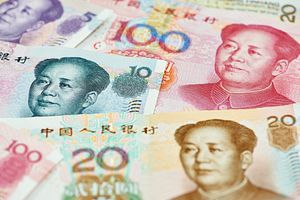The renminbi, China’s currency, is witnessing interesting times in the second half of 2015. In the late summer, following months of turbulence in China’s equity markets, the People’s Bank of China (PBOC), the country’s central bank, intervened to adjust the renminbi’s managed float to keep it in line with market forces. In effect, this meant a four percent devaluation, leading to criticism in the United States that China was initiating a new trade war to benefit its exporters. A lower renminbi does benefit Chinese exporters, but the overall economic picture is more complicated. (I wrote in more detail on the PBOC’s first devaluation and why the “currency war” narrative was simplistic at the time.)
Beyond the PBOC’s moves in August, which cast a pall on the Chinese currency’s stability and future trajectory, the renminbi received a major boon on the final day of November 2015, when the International Monetary Fund added the currency to its elite Special Drawing Rights (SDR) basket. The renminbi’s inclusion in the SDR basket, on the surface, meant that the IMF had deemed it both “widely used” and “freely usable.” The former had been uncontroversial given China’s mammoth global footprint as a trading nation. The latter, however, was more difficult for the IMF to certify.
Taken together, the PBOC’s growing interventionism (motivated by the Chinese Communist Party since the bank is not a politically independent central bank), and the IMF’s decision to include the renminbi in the SDR basket have seen the renminbi depreciate against the dollar. In the weeks since the IMF’s decision in particular, the renminbi dropped nearly 1.5 percent against the dollar. The PBOC’s ability to rein in this depreciation, which helps Chinese exporters but reflects a weakening Chinese economy, is limited. Wealthy Chinese, amid expectations that China’s economy will continue to flounder and taking advantage of the renminbi’s newfound ‘free usability,’ continue to move their money abroad.
The renminbi’s depreciation appears to be more than a short-term consequence of events in the second half of 2015. Experts expect a stabilization for the renminbi at an even lower level. Ryan Lam, the head of research at Shanghai Commercial Bank, tells the New York Times that his institution is “looking for larger depreciation in the first half of next year, and then a stabilization.” Currency markets tell a similar story—demand for the renminbi, after the IMF’s decision in particular, has been lackluster.
The renminbi’s continued depreciation may mean that a long-expected shift in Asia, in which a rising renminbi combined with rising wages in China would lead to a manufacturing boom in poorer, mostly South Asian countries, will be delayed. China’s status as a manufacturing powerhouse may be here to stay, vexing countries like India and Bangladesh, which appeared poised to reap the rewards of a continually ascendant China with a strengthening currency. The Indian government under Narendra Modi had made manufacturing growth a priority, but the latest data suggests New Delhi’s efforts—including its “Make in India” initiative—are failing to pay dividends.
It’s unclear if the PBOC will receive the political go-ahead from the Communist Party to make any drastic moves to rein in the renminbi’s depreciation. Current depreciation rates may be inadequately dramatic to turn around the fortunes of struggling exporters in China. Additionally, a weak renminbi means that raw materials that need to be sourced abroad for Chinese exporters are costlier. What’s more, the Federal Reserve’s rate hike complicates matters further and encourages capital flight since Chinese investors now have reason to hold dollars over the renminbi. Cutting rates in China can spur spending, which is doubtless important for Chinese companies hurting from this past summer’s stock market volatility, but it will also have the undesired effect of encouraging capital flight.
Heading into 2016, it will be worthwhile for observers of Asia to continue to watch the renminbi closely. The currency will continue to be instructive of more than just the health of the Chinese economy. In many ways, 2015 marks the renminbi’s entry into uncharted waters as an increasingly internationalized currency. In 2016, China’s monetary policy-makers may find that the renminbi’s new-found status means acquiescing to a hard reality of prolonged depreciation until broader structural reform helps the Chinese economy pick back up.

































